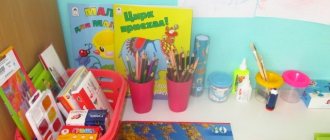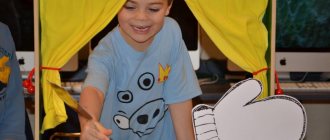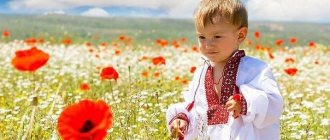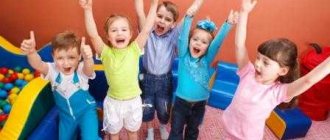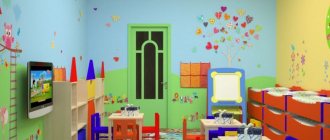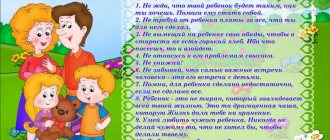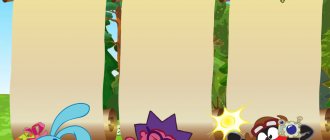Entertaining mathematics corner
Tatyana Goryacheva
Entertaining mathematics corner
Mathematics enters a child’s life from the moment of birth. But acquaintance with mathematics and its concepts must be done with the help of aids in games, unobtrusively, without destroying the natural life of children. If from the very beginning you give your child the opportunity to make friends with mathematics and see it as an interesting game, then later, at school, only positive emotions will be associated with this science, and interest in the subject will develop.
For this purpose, the group has created an entertaining mathematics corner or math center.
The mathematics center is a specially designated place, thematically equipped with games, manuals, and materials. By creating a math corner, we provided children with free access to materials and games, thereby giving children the opportunity in their free time to choose a game, manuals, etc. that interest them, and play individually or together with other children.
Stages of working with the puzzle:
Stage 3
-recreation of figures using contour patterns is the most difficult and interesting activity for children.
Compiling figures according to your own ideas turned out to be no less interesting.
For the math center, I printed out tangram diagrams and made several sets of figures so that in their free time the children could play, as mentioned above, individually or together with other children.
I also use Tangram games as part of math lessons. At my request, my parents made multi-colored tangrams (size 10X10) according to the pattern. We put them in bags, and each child used their own set during the lesson.
Practice with Cuisenaire sticks
children can also work individually or in groups of several people, in small subgroups; frontal work with all children is also possible.
Checkers and chess promote the development of logical thinking.
"Fun Math"
contains sets of fascinating logic tasks: these include labyrinths, “find the differences”, etc.
I bring interesting logical tasks to the math center, cut out from various magazines.
“Entertaining Mathematics Corner” for children 4–5 years old With the aim of developing in children 4–5 years old an interest in elementary mathematical activities, developing the quality and personality of the child.Summary of a mathematics lesson in the preparatory group “Journey into the world of entertaining mathematics” Purpose: Consolidation of knowledge on the material covered. Objectives: • Exercise children in counting within 100. • Counting backwards within 20. •.
Consultation for educators “Fascinating Mathematics Corner” Consultation for educators “Fascinating Mathematics Corner” Among the conditions necessary for the formation of a preschooler’s cognitive interests.
The world around us through the eyes of entertaining mathematics “Journey to the entertaining country “Mathematics”” “Journey to the entertaining country “Mathematics” (preparatory group) Objectives: 1. Systematize children’s lessons about numbers and geometric figures.
Experimental activities with elements of entertaining physics in a preschool educational institution “An empty head does not reason: the more experience, the more capable it is of reasoning.” P. P. Blonsky A process is actively taking place in the country.
Organization of an entertaining mathematics center in a group Video Municipal autonomous preschool educational institution “Kindergarten No. 35 of Blagoveshchensk” REPORT on the topic: “Organization.
Teachers' council on the topic: “Formation of elementary mathematical concepts using entertaining mathematics.” Teachers' council on the topic: “Formation of elementary mathematical concepts using entertaining mathematics.” Compiled by a senior teacher.
Project for mathematical development “The road to the world of entertaining mathematics with Dienesh blocks” Relevance of the project. One of the important tasks highlighted by the Federal State Educational Standard in the work of a preschool educational institution is cognitive requirements.
Source
Requirements for organizing a corner according to Federal State Educational Standards
In order for the mathematics corner to fully comply with federal state educational standards, you need to remember a number of factors at once.
Safety and protection of child's life:
- The material equipment of the corner should not contain any items potentially hazardous to life and health (pea seeds, beans, buttons, beads, etc.). If bags, for example, with beans, are needed for the development of fine motor skills, then they must be tightly tied or sewn up, and work with them must be carried out strictly under the supervision of a teacher;
- Do not use geometric shapes made of hard plastic. The child may be injured by their corners. You should choose either soft plastic or cardboard;
- The places where toys are stored should be at the child's eye level so that he does not need to reach for them or stand on a chair. All shelves must be firmly attached to the wall;
- The corner should be in a well-lit place. There should be tables and chairs nearby where mathematical games will be played. They must match the height of the children.
Accessibility and age-appropriateness of the group. All materials must be selected based on this criterion. You can take an additional three or four games for advanced development from tasks for older ages.
One of the criteria for designing a math corner according to the Federal State Educational Standard is the diversity of its content. The games contained in it must cover all those areas that are considered within the framework of the FEMP program.
The connection between mental, practical and experimental activities:
- in accordance with the standard, children should not only be able to see the number in the picture and correlate the number of drawn objects with it, but also, with the help of natural material, independently add this number, decompose it into parts, and perform other actions that interest them;
- It is important to have a wide selection of geometric materials so that children gain a complete understanding of the shape and properties of shapes.
In the mathematics corner, all conditions must be created for creative self-expression and development of children. There should be materials for modeling, geometric coloring books, even counting sticks, which children love so much. Everything is limited only by the teacher’s imagination.
Important!
From the first day, it is necessary to teach children to clean up after themselves, put everything neatly on shelves, and put it in its place. This will help avoid clutter in the corner and teach “little mathematicians” discipline and responsibility.
Design and content of the mathematical corner in the preparatory group
Olga Priputneva
Design and content of the mathematical corner in the preparatory group
Design and content of the mathematical corner in the preparatory group “Pochemuchki”
»
Goal : to promote the development of cognitive activity, logical thinking, the desire for independent knowledge and reflection.
Objectives: to develop children's mathematical abilities; interest in the subject of mathematics.
The corner is organized using special shelves in a cozy, quiet and peaceful place. At the same time, children have free access to the materials used. Thus, children are given the opportunity, in their free time from classes, to choose a game that interests them, a manual with mathematical content, and play individually or together with other children in a small subgroup.
The selection of gaming material corresponds to the capabilities and level of development of children in the preparatory group. A variety of mathematical material can be classified into 3 categories: entertainment; mathematical games and problems; educational games and exercises. Each child can choose a game based on their interests. These are board and printed games, games for the development of logical thinking, puzzles, logic problems, cubes, chess, educational books. To stimulate collective games and creative activities, magnetic boards, counting sticks, sketchbooks, and a poster with mathematical problems were used.
The composition of the math corner may not change for a week or even two when both the teacher and the children constantly need to refer to it. But, if a change in material has occurred, children need to point this out or ask them to notice it, and give them the opportunity to consider the new mathematical material.
"Happy birthday". Decorating a corner in a group Teacher S. A. Klyueva Good afternoon, colleagues! I want to share with you the idea of decorating a “Happy Birthday” corner. Childhood is the most wonderful. Decoration of the New Year's corner in the group I present for your consideration: a photo of the decoration of the New Year's corner in my group. My group is of an early age. I really wanted to create a New Year's one.
Methodological recommendations for educators “Content of a corner on labor education in different age groups” “Content of a corner on labor education in different age groups” The work of children in kindergarten is diverse. This allows you to support.
Methodological recommendations “Maintaining a book corner in a preschool institution” A book corner is a necessary element of a developing subject environment in a group room of a preschool institution. Its presence is mandatory.
Contents of a corner of nature “The world contains not only necessary and useful things, but also beautiful things. The world surrounding a child is, first of all, the world of nature with limitless wealth.
Design of a national corner in the middle group An important component of the educational environment in the group is the national corner. It has the function of instilling patriotic feelings in children. Design of the traffic rules corner and the fire safety corner The traffic light is a road friend - Controls everything around. Red light is a menacing sight. He is fraught with danger. If the light burns like this, it means like a soldier. Designing a traffic rules corner in the middle group To familiarize children with the rules of the road, our group made a real road, with markings, signs and traffic lights.
The content of the physical education corner in accordance with the Federal State Educational Standard in the second junior group of the kindergarten. The presentation of the physical education corner meets the requirements of the Federal State Educational Standard in the second junior group of the kindergarten. It contains attributes for mobile people.
Source
Tasks of organizing mathematical corners
In early kindergarten groups, they organize not mathematics corners, but sensorimotor zones, equipment that introduces children to the color, shape, size of objects, promotes the development of fine and gross motor skills, spatial orientation, but does not concern the actual mathematical concepts and operations, such as quantity, comparison of objects in a group, formation of sets, etc.
Math corners are set up in groups for children four years of age and older. The purpose of their creation is to stimulate the cognitive activity of children and encourage them to engage in a variety of activities in the field of mastering mathematical concepts, skills, and abilities in accordance with their age-related psychophysiological characteristics.
The objectives of organizing a math corner in a kindergarten group:
- Enrich the group’s developmental environment with materials and equipment aimed at developing mathematical concepts. Developing children's thinking is no less important than promoting their physical or speech development.
- Organize work on developing children’s mathematical understanding. By collecting all the games in one place, systematizing manuals and literature on mathematics, the teacher has the opportunity to carry out targeted work with children and share experience with colleagues, which contributes to the further replenishment and improvement of the group’s developmental environment. In addition, the teacher sees what materials are sufficient in the corner, and what needs to be made and updated. If games and equipment are stored in different places, unsystematically, it is much more difficult to keep track of them and replenish them in a timely manner.
- To increase children's interest in engaging in a variety of activities related to mathematics. Bright, entertaining filling of the corner will certainly attract the attention of even those children who do not show interest in organized activities in FEMP, and will allow them to develop their mathematical abilities gradually, indirectly: for example, if a child likes to draw, then he can be asked to decorate an image of a house, a fish, tree, made up of geometric shapes, naming each figure (“Now let’s color this triangle - the roof. What color will it be?”) or “revive” the silhouette of the number (“This two looks like a duck, you just need to finish drawing its beak, eyes and paws"). Some children grasp much faster information that is presented not as main, but as secondary, which is used during creative and playful activities in the mathematics corner.
- To promote the development of gifted children, to satisfy their increased need to learn new things. To do this, the mathematics corner should contain materials that are “ahead” of the students’ age. For example, in the middle group, where children, according to the program, are introduced to numbers from 1 to 5, you can place cards with entertaining images of the numbers 0, 6–9, which will certainly interest the most inquisitive “mathematicians.” The teacher should explain to those children who show interest what these numbers are, how many objects they correspond to (mathematical puzzles, lotto will help here), praise the children for their attentiveness and inquisitiveness. In the senior group, the advanced development of pupils will be facilitated by a selection of logical exercises: joke problems, intelligence exercises, memory and attention development, as well as all kinds of puzzles.
- To encourage children to develop a need not only for activities with toys, fun, and entertainment, but also for games where they need to show their thinking abilities, intelligence, and reveal the meaning of such games: to achieve victory, to become the first thanks to their knowledge, intelligence, and ingenuity.
- Develop the ability to organize your free time, choose an activity based on your interests, engage in your favorite activity with friends, help them master skills (lay out a pattern of figures, sequence, correlate a number and a number).
- Develop thought processes, intelligence, resourcefulness, cultivate independence, organization and even courage. Sometimes timid, indecisive children do not answer in class because they are afraid of making mistakes and are unsure of themselves. In a mathematical game, they express themselves and give the teacher the opportunity to evaluate their real knowledge and skills. Having answered correctly during the game, having received the support of the teacher and friends, preschoolers (especially older ones) often get rid of the fear of being ridiculed for making a mistake and begin to behave actively in class.
You can also master new knowledge in an exciting mathematical game together with a teacher.
Corner on the formation of mathematical concepts in the younger group
AYGUL Bagauova
Corner on the formation of mathematical concepts in the younger group
The mathematics corner in the junior group in a preschool educational institution according to the Federal State Educational Standard, Federal State Educational Standard for Preschool Education, clearly describes the requirements for creating a developmental environment. We work according to the “Igralochka”
L. G. Peterson.
In the junior group, 8 lessons are aimed at studying the topic “Color”
and
“Shades of Colors,”
so I paid special attention to games to reinforce these topics.
The developing subject-spatial environment in a preschool educational institution should be: content-rich, developing; transformable ; multifunctional; variable; accessible; safe; health-saving; aesthetically attractive. Before thinking about filling the math corner, you need to look at the program and remember the sanitary standards. In the math corner , in addition to textbooks for classes, there should be games for individual work, games of more complex options (aimed at taking into account the individual characteristics of the child, at consolidating last year’s material . Children’s attention is always attracted by homemade teaching aids and materials that can be used not only in mathematical corner ... I wanted to show you how I designed the mathematics corner in the junior group .
We also prepared demonstration and information material :
• Mathematical tales
• Entertaining material
• Mathematical physical education minutes
• Card index of didactic games
Summary of a lesson on the formation of mathematical concepts in the junior group “Vaska the Cat Visiting the Children” Summary of a lesson on the formation of mathematical concepts in the junior group. Goal: Formation of initial in children.
Comprehensive thematic planning for the formation of elementary mathematical concepts in the preparatory group Month: September Week: I and II Direct educational activities: Topic: “Monitoring” Month: September Week: III Directly.
Summary of educational activities for the formation of elementary mathematical concepts in the junior group “The bear brought a treat” “The bear brought a treat” Objectives: Learn to form a group of individual objects, use the words “Many” and “One”, agree on the numeral.
Abstract of the GCD on the formation of elementary mathematical concepts in the preparatory group “Let's help Dunno” “Let's help Dunno” Motivation: Dunno asks the guys for help: to teach him how to guess his mathematical riddles Goal: Formation of primary ones.
Source
Developmental environment. Mathematics corner in the second junior group
Kintaeva Aigul
Developmental environment. Mathematics corner in the second junior group
Mathematical
The mathematics center is a specially designated place, thematically equipped with games, aids, and materials .
The first step in designing an environment is to determine the location of the centers in the group room .
By creating a math corner , we provided children with free access to materials and games . This gives children the opportunity in their free time to choose a game that interests them, benefits, etc. Play individually or together with other children.
For preschool children, play is the leading form
Didactic games were created for learning through play. Didactic
the game makes it possible to solve various pedagogical problems in
Children play without suspecting that they are acquiring some knowledge,
master the skills of operating with objects, learn the culture of communication
A variety of entertaining material is placed in the corner so that each child can choose a game according to their interests.
Matryoshka dolls, pyramids, mosaics.
Games for determining shapes and sizes: inserts, magic cubes, houses. And also homemade games: “Magic Box”
,
“magic caps”
,
“Geometric lotto”
,
“
Math box ” ,
“Many, few, one”
,
“Color panel”
,
“More-less”
games with clothespins,
“Soft
educational book ” .
Our mathematical center solves the following problems:
Development of thinking and finger motor skills.
Mastering the operations of nesting, overlaying, connecting parts into a whole.
Development of visual perception and attention.
Formation of examination skills.
Familiarity with geometric figures and shapes of objects.
Learning to group objects by color , size, shape.
Identification of the relationship between groups of objects by quantity and number (many, few)
.
Developing the ability to use language to determine the meaning of one's actions.
Developing the ability to group objects and compose pictures sequentially. Enriching children's active vocabulary.
Formation of the ability to describe and name objects in pictures.
I would like to present to your attention hand-made games
Photo report “Book corner as a developmental environment in a group” A properly organized developmental environment in which a child lives contributes to his development. The role of an adult is to do the right thing. Subject-developing, play environment in the second junior group Subject-development, play environment Subject-development, play environment is a system of material objects of a child’s activity, which. Subject-developing environment in the second junior group Co-authors: Semechkina Ekaterina Evgenievna Chervonnaya Tatyana Sergeevna The subject-development environment created in our group corresponds. Subject-based development environment in the second junior group The proms have passed, we have just said goodbye to our dear and beloved students, and now we need to prepare the group to meet new ones. Developing subject-spatial environment in the second junior group Presentation of a developing subject-spatial environment in the second junior group. Good afternoon, dear colleagues! We bring to your attention. Developing subject-spatial environment in the second junior group Children spend a lot of time in kindergarten, so the environment should meet their interests and develop each individual’s individuality. Developmental environment. Book corner in the preparatory group Book corner. Research by Professor John Stein suggests that reading good books helps improve mental health. Developmental environment in the group “Corner of Solitude” Good afternoon, dear colleagues! According to the Federal State Educational Standard for Educational Education, a developing subject-spatial environment in preschool educational institutions.
Source
The relevance of logical and mathematical zones in preschool institutions
The rapid development of science and high technology these days requires educational institutions to take a new approach to teaching the younger generation. They should not only equip children with knowledge and skills, but also develop life competencies, without which it is impossible to become successful and in demand in the modern world:
This work begins in preschool educational institutions (DOU). Modern exemplary educational programs proclaim one of the most important tasks of a preschool institution is the formation of a comprehensively developed, creative individual striving for active knowledge of the world around him. An important component of the comprehensive development of a child is logical and mathematical. And, in turn, zones of logical and mathematical development (mathematical corners) are a necessary part of the general developmental environment in a preschool educational institution.




